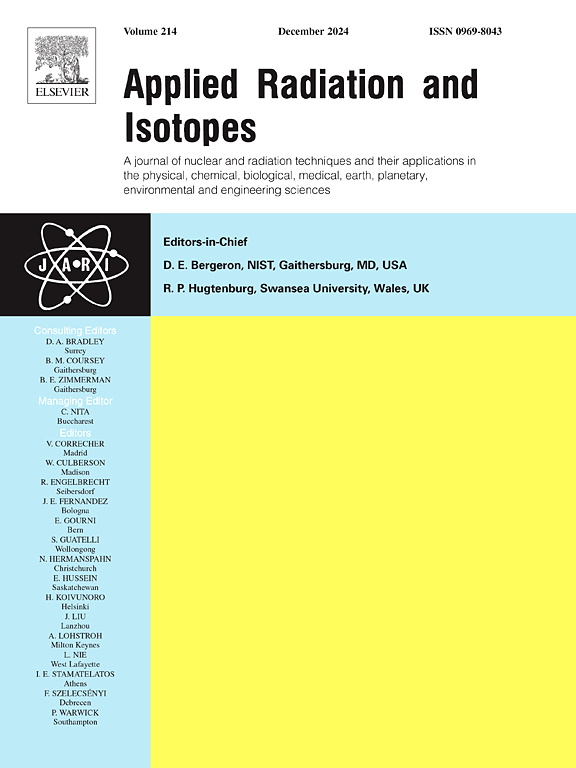Spectrophotomaterically study for PS and MO/PS composites as high-doses dosimeters
IF 1.6
3区 工程技术
Q3 CHEMISTRY, INORGANIC & NUCLEAR
引用次数: 0
Abstract
The present work concerns preparing and characterizing polymer systems for dosimetry applications. The samples were cast as a thin film from homopolymer (Polystyrene (PS)) before and after doping with Methyl Orange (MO) at different weight ratios of (0.2 %, 0.4 %, 0.6 %, 0.8 %, and 1 % wt./wt.). The prepared samples were irradiated with 60Co (gamma source) within a range of (1–13 kGy). The polymer systems were evaluated spectrostomaterically for use as high-dose dosimeters. The absorption spectra of prepared samples before and after irradiation manifested the Gamma radiation-induced absorption changes with the absorbed doses (Systematic changes) for (PS and 0.2 % MO/PS), and unsystematic for the others. The calibration plots were selected at (700 nm) wavelength for their linear response at this wavelength. The results proved that the PS and 0.2 % MO/PS can be used as dosimeters for their linear response to the radiation dose. The effective dose range in the linear part for PS and 0.2 % MO/PS was (1–13 kGy), and the maximum optical absorption difference reached 1.291 and 1.122, respectively. The two dosimeters show perfect stability for 20 days. The FTIR and optical microscope results were investigated. The photographs elucidated the surface damage, i.e., grooves, holes, bubbles, and cracks induced by photodegradation for the samples involved. It was seen that the PS and 0.2 % MO/PS were promising for use as high-dose dosimeter applications.
PS和MO/PS复合材料作为高剂量剂量计的分光光度研究
目前的工作是制备和表征用于剂量学应用的聚合物体系。在不同重量比(0.2%、0.4%、0.6%、0.8%和1% wt /wt)下,将均聚物(聚苯乙烯(PS))掺杂甲基橙(MO)前后的样品浇铸成薄膜。用60Co (γ源)在(1-13 kGy)范围内辐照制备的样品。对聚合物体系进行了光谱材料评价,以作为高剂量剂量计使用。辐照前后样品的吸收光谱显示,γ辐射诱导的吸收随吸收剂量的变化(PS和0.2% MO/PS)呈系统变化,其他样品呈非系统变化。在(700 nm)波长处选择校准图,以确定其在该波长处的线性响应。结果表明,PS和0.2% MO/PS对辐射剂量有线性响应,可以作为剂量计。PS和0.2% MO/PS的线性部分有效剂量范围为(1 ~ 13 kGy),最大光吸收差分别为1.291和1.122。这两个剂量计在20天内表现出完美的稳定性。研究了FTIR和光学显微镜结果。这些照片阐明了所涉及样品的表面损伤,即由光降解引起的凹槽,孔洞,气泡和裂纹。由此可见,PS和0.2% MO/PS有希望作为高剂量剂量计应用。
本文章由计算机程序翻译,如有差异,请以英文原文为准。
求助全文
约1分钟内获得全文
求助全文
来源期刊

Applied Radiation and Isotopes
工程技术-核科学技术
CiteScore
3.00
自引率
12.50%
发文量
406
审稿时长
13.5 months
期刊介绍:
Applied Radiation and Isotopes provides a high quality medium for the publication of substantial, original and scientific and technological papers on the development and peaceful application of nuclear, radiation and radionuclide techniques in chemistry, physics, biochemistry, biology, medicine, security, engineering and in the earth, planetary and environmental sciences, all including dosimetry. Nuclear techniques are defined in the broadest sense and both experimental and theoretical papers are welcome. They include the development and use of α- and β-particles, X-rays and γ-rays, neutrons and other nuclear particles and radiations from all sources, including radionuclides, synchrotron sources, cyclotrons and reactors and from the natural environment.
The journal aims to publish papers with significance to an international audience, containing substantial novelty and scientific impact. The Editors reserve the rights to reject, with or without external review, papers that do not meet these criteria.
Papers dealing with radiation processing, i.e., where radiation is used to bring about a biological, chemical or physical change in a material, should be directed to our sister journal Radiation Physics and Chemistry.
 求助内容:
求助内容: 应助结果提醒方式:
应助结果提醒方式:


